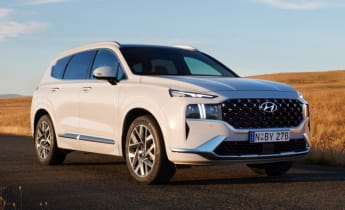The Hyundai Santa Fe is a seven-seater SUV that slips in-between the enormous Palisade and mid-sized Tucson in Hyundai’s line-up.
And while it seemed to be the SUV that had everything, from unconventional good looks to cool tech, there’s never been a hybrid version despite rivals such as the Mitsubishi Outlander PHEV and Kia Sorento hybrid being on the market... until now.
Yep, 'better late than never' isn’t just the motto of my punctuality-challenged family, it’s also the case with the Santa Fe Hybrid.
In many ways, the Santa Fe Hybrid makes up for its lateness with a drive experience better than the regular Santa Fe - and you’ll save fuel, too.
I’ll tell you how much fuel you’ll save below, along with how much more you’ll pay to own a Santa Fe Hybrid over a regular Santa Fe. I’ll also cover off its safety tech, standard features and practicality.
Hyundai Santa FE 2023: Highlander HEV (7 Seat)
| Engine Type | Turbo 4, 1.6L |
|---|---|
| Fuel Type | Unleaded Petrol/Electric |
| Fuel Efficiency | 6.0L/100km (combined) |
| Seating | 7 |
| Price From | $49,170 - $56,540 |
| Safety Rating |
|
Does it represent good value for the price? What features does it come with?
7 / 10
Hybrids cost more than their petrol and diesel equivalents, but how much more depends on whatever the car manufacturer decides you should pay.
Hyundai is charging $6500 extra for the Santa Fe hybrid over the petrol version and $3000 more than the diesel.
Also, for now, you can only get the Hybrid on the Elite and Highlander grades, the two most expensive levels in the Santa Fe line-up.
_0.jpg)
This means you’ll pay a list price of $63,000 for the Santa Fe Elite Hybrid and $69,550 for the Highlander Hybrid.
The standard features for the Elite Hybrid and Highlander hybrid are exactly the same as their petrol and diesel equivalents, except for the wheels. The hybrids have smaller 19-inch wheels (they’re 20-inch alloys on the regular Santa Fe) that Hyundai says are designed to be more aerodynamic.
So, along with those futuristic wheels, also coming standard on the Elite Hybrid are LED headlights and tail-lights, a gesture tailgate, privacy glass, proximity key with push-button start, a 10.25-inch media display, 12.3-inch instrument cluster, 10-speaker Harman Kardon stereo, leather upholstery, heated front seats with a power driver’s seat, dual-zone climate control, a wireless charger, sat nav, plus Apple CarPlay and Android Auto.
.jpg)
The Highlander Hybrid has all of that, but adds Nappa leather upholstery, a power front passenger seat, ventilated front seats and heated window seats in the second row, a head-up display and a panoramic sunroof.
The Elite and Highlander are both seven seaters, but you can ask for six seats in the Highlander and have that second row bench seat replaced with two captain’s chairs.
What are the key stats for the engine and transmission?
8 / 10
The Santa Fe Hybrid is not a plug-in hybrid like the Mitsubishi Outlander or Kia Sorento. That means you don’t need to connect the battery to a power outlet to charge it. Instead, the battery charges on the go as you drive it, and through regenerative braking.
Under the bonnet is a 1.6-litre, four-cylinder, turbo-petrol engine and an electric motor. They have a combined output of 169kW/350Nm.
.jpg)
That’s pretty good grunt. Just as a comparison, the V6 makes 200kW/331Nm, while the diesel engine produces 148kW/440Nm.
If you’re planning on towing, then the diesel and petrol are clearly the better choices with their 2500kg braked towing capacity, compared to the hybrid’s 1650kg.
The Hybrid Santa Fe is also all-wheel drive and a six-speed automatic transmission shifts gears smoothly.
.jpg)

How much fuel does it consume?
8 / 10
This is what it’s all about isn’t it? How much fuel does the Santa Fe Hybrid use?
Hyundai says this hybrid will use 6.0L/100km after a combination of open roads and urban driving. That is excellent, but if this was a plug-in hybrid (PHEV) that figure could be as low as 4.0L/100km.
Still, the Santa Fe hybrid is much more fuel efficient than the V6 variant which uses 10.5L/100km.
.jpg)
I took a look at the drive history of the Santa Fe Hybrid I tested at the end of the Australian launch.
According to the trip computer the car had travelled 967.2km and had used an average of 7.3L/100km.
About 500 of those kilometres were done by me with peak hour city traffic, country roads and motorways all in there. That’s great fuel efficiency, but a Santa Fe PHEV would do better.
As I said earlier, there’s no need to plug the Santa Fe into an external power supply to charge its lithium-ion battery, it’ll charge itself automatically through normal driving.
.jpg)
Is there anything interesting about its design?
8 / 10
There’s only one way to tell the hybrid version of the Santa Fe from the petrol and diesel variants - the wheels. The hybrid's wheels are smaller and have a sort of ‘cog’ design to them. I’m not a fan of the styling, but they’re supposed to be aerodynamic and save fuel.
Overall, I am a fan of the Santa Fe’s looks which were given a major change in 2020 with a completely different grille and interior.
I like the way Hyundai has moved away from giving all its cars the same face, with each model now having its own visual identity.
.jpg)
The Santa Fe’s wide, cat fish-like gaping mouth grille might not be for everybody, but it sure doesn’t look like the front of any other SUV on the market.
The rear of the Santa Fe is far more conservative but looks prestigious enough to stop short of the boredom threshold.
It’s far from boring inside with the dash sculptured into what appear to be rock pools, with geyser-like air vents and a floating centre console.
.jpg)
Again, no sign this is a hybrid in the cabin either, which is the way it should be, or will be when electric vehicles become the norm.
The cabins of the Elite and Highlander are filled with leather and modern tech. It’s a plush place made even plusher on the Highlander with its Nappa leather upholstery.
The Santa Fe is a big, mid-sized SUV at 4.8m end-to-end, but it’s not as large as a Hyundai Palisade. That's huge at five metres long.
.jpg)
How practical is the space inside?
8 / 10
The Santa Fe is among only a handful of mid-sized SUVs offering seven seats. The third-row seats are really designed to be used occasionally. They’re flat and fairly hard and the passengers back there aren’t fully covered by the side curtain airbags.
The second row offers plenty of room. Enough, even for me at 191cm, to sit comfortably behind my driving position.
And if you’d like more space then the Highlander grade allows you can replace that bench seat with two captain’s chairs in the six-seat version.
Clever cabin storage spaces can be found throughout. I particularly like the floating centre console with an area underneath big enough for a small backpack, and the shelf above the glove box in the dash is also good for throwing a wallet or phone.
Big door pockets, cupholders and a deep centre console storage box are also on board.
For charging devices there are five USB ports (two up front, two in the second row, and one in the third), two 12-volt outlets (front seats and cargo area) and a wireless phone charger.
.jpg)
While there isn’t three-zone climate control. There are directional air vents in all three rows and the Elite and Highlander grades also come with pull-up sun shades for the rear windows.
As for the boot, most of the time you’ll probably have the third-row seats folded flat, and that’ll give you a cargo capacity of 571 litres.
Or, if you are using the third row there’s 130 litres of space left for you to use.
Warranty & Safety Rating
What safety equipment is fitted? What safety rating?
8 / 10
The regular Santa Fe scored the maximum five-star ANCAP rating when it was tested in 2018. You don’t need me to tell you the world was a different place back then, as it was in terms of automotive safety requirements.
New advanced safety tech has been added to this SUV over the years and this Santa Fe hybrid comes equipped with all of it, too.
There’s AEB which works at intersections, too, blind-spot warning, rear cross-traffic alert, lane keeping assistance, rear occupant alert, auto high beam headlights and adaptive cruise control.
.jpg)
The forward AEB will bring the vehicle to a complete stop for cyclists and pedestrians at speeds between 10km/h and 65km/h or 75km/h for vehicles.
Above the speeds the vehicle will slow as much as possible in an attempt to avoid a collision.
The Highlander adds even more tech in the form of a surround view camera, blind spot monitor, and rear AEB.
.jpg)
This top grade also boasts remote parking that allows the you to drive the Santa Fe in or out of tight parking spots using the key fob as a remote control. It sounds incredible but it’s real. I’ve demonstrated this feature in the video above.
On a super serious note be aware that even though this is a three-row SUV, the curtain airbags don’t completely cover the third row windows.
The Santa Fe isn’t the only SUV with this airbag inadequacy - the Kia Sorento has the same problem.
What does it cost to own? What warranty is offered?
8 / 10
The Santa Fe Hybrid has the same warranty as the rest of the range at five years/unlimited km. The battery is covered by an eight-year/160,000km warranty, which is pretty standard for hybrids.
Servicing is required every 10,000km/12months, however, the costs were yet to be finalised at the time of publishing.
.jpg)
What's it like to drive?
9 / 10
You’re not just getting better fuel economy in the hybrid version of the Santa Fe, you’re getting a better SUV to drive.
That’s what I found when I tested the Santa Fe Hybrid at its Australian launch. The ride is more comfortable and the steering feels more responsive and lighter than the V6 petrol or diesel Santa Fe, both of which I’ve driven extensively.
The better ride I think comes down to the stabilising effect of extra weight situated low from the batteries (they’re located under the driver). Hyundai told me the front suspension had been revised to deal with the added weight, too.
.jpg)
So, I feel the ride is now more comfortable, less jittery with a smidge more planted feeling to the handling.
The lighter and better steering feel may have something to do with having a smaller engine in the nose of the Santa Fe. The 1.6-litre four-cylinder weighs less than the 2.2-litre diesel engine and the V6 petrol. That lighter font end now has a more ‘pointable’ feeling.
That said, the electric motor would add more weight to the Santa Fe hybrid’s nose, too.
.jpg)
Another difference to the way the hybrid drives is the take-off acceleration. It’s quite sudden and forceful for a family SUV in this class and that’s due to the 350Nm of torque, available from 1000rpm.
That’s great for moving away out of a car space and quickly blending into traffic, or accelerating away from traffic lights.
Visibility as with the regular Santa Fe is excellent and parking is easy, too, given this isn’t a large SUV.
.jpg)
Verdict
The Santa Fe Hybrid is a better Santa Fe to drive than the V6 petrol or the diesel variant. It’s also a lot more fuel efficient, but the value isn’t as great at this price. Also keep in mind that the Hybrid has a much lower braked towing capacity relative to the diesel and V6 petrol Santa Fes.
The Elite grade will save you money, and you’re not missing out on many luxuries.
Note: CarsGuide attended this event as a guest of the manufacturer, with accommodation and meals provided.
Pricing Guides


.jpg)
.jpg)
.jpg)
.jpg)
.jpg)
.jpg)
.jpg)
.jpg)
.jpg)
.jpg)
.jpg)
.jpg)
.jpg)
.jpg)
.jpg)
.jpg)
.jpg)
.jpg)







































.png)








.png)



.jpg)





